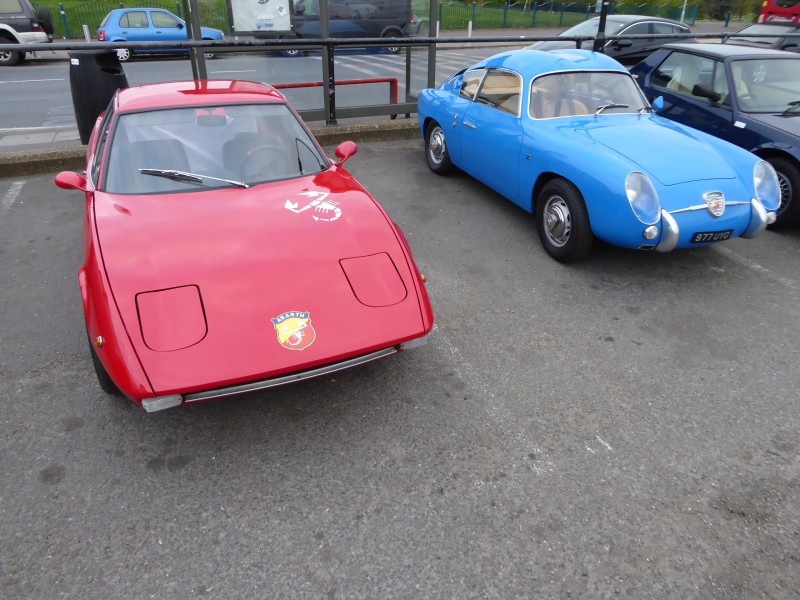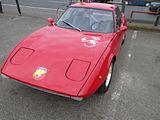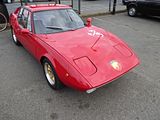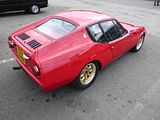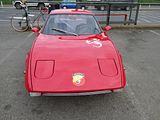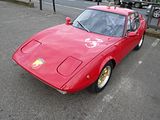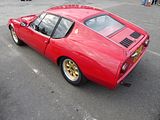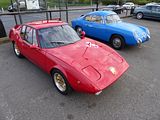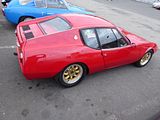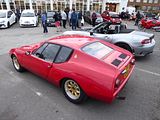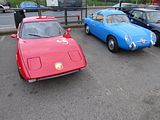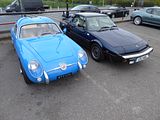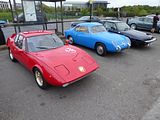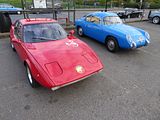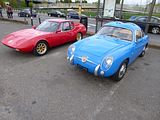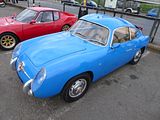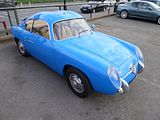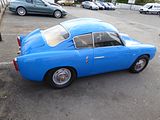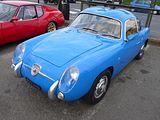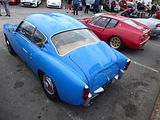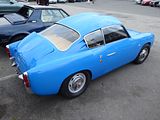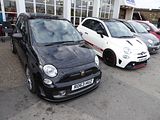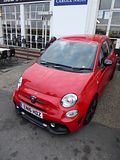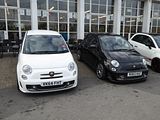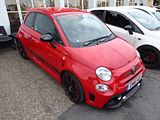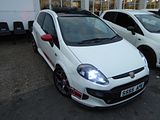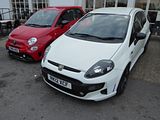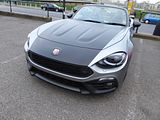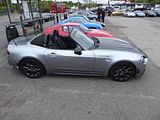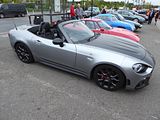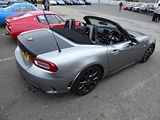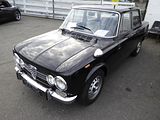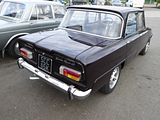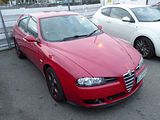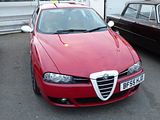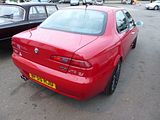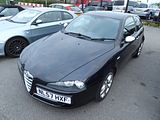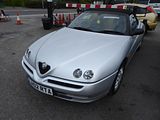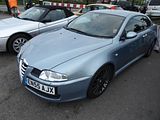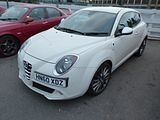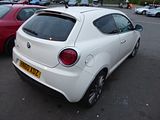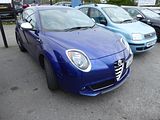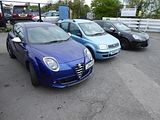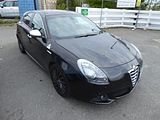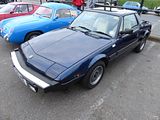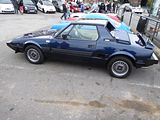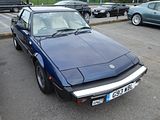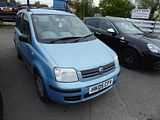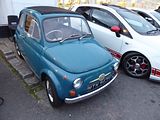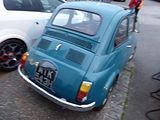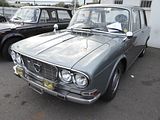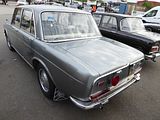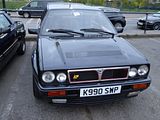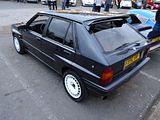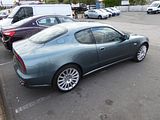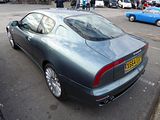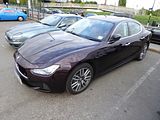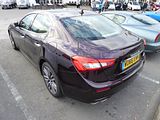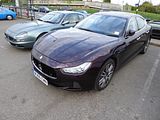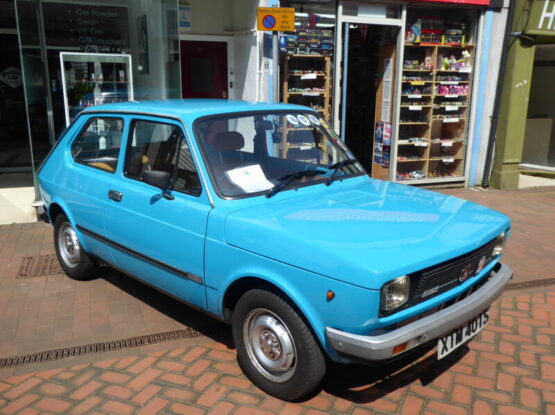For the car enthusiast, April is an exciting month of the year, as it is when the events season really kicks off, with something to see and do now in prospect for pretty much every weekend for the next 6 months. Thanks to the extra daylight, further helped by the change to British Summer Time, suddenly evening events during the week start to become more viable, as well, with darkness not falling until after 8pm. That means that attendance at the popular Ace Cafe themed evenings, which do carry on all year round usually picks up noticeably. Couple that with a dry evening, and I thought that the April Italian Cars evening – the first I have attended in the daylight since last August, I noted from my records – should have had a huge turn out. Maybe the fact that the date happened to the start of the Easter Holiday long weekend acted against things, as when I got to the site at just before 6pm, there were not that many cars on the forecourt, and quite a few of them were not even Italian. These were moved out fairly soon thereafter, and more Italian machinery did arrive, but this was far from the busiest that I have seen this venue get. However, as the saying goes, sometimes it is quality not quantity that counts, and in terms of variety and some rare cars, then this was still a good evening, as this report will evidence.
ABARTH
On arrival, I was expecting to see a line of Abarths, parked up against the Cafe, and indeed they were there, and I will get to them, but my eye was caught by something much much rarer. Indeed, were it not for the Abarth badge on the front, I am sure that most people would not have a clue as to its marque. No-one much seemed to have an idea what specific model it was, and that is no surprise, as this is an extremely rare car. I think I’ve seen one at Prescott a couple of years ago, and one at the Auto e Moto d’Epoca in Padua, which about the best place anywhere to find unusual Italian cars. It is an Abarth Scorpione 1000, a car you’ve probably never heard of. And when I tell you that it was based on the Lombardi Grand Prix, you will probably say you’ve never heard of that, either! The Lombardi Grand Prix was a small, rear-engined sports car, based on Fiat 850 underpinnings, developed by the Carrozzeria Francis Lombardi with an in-house design by Giuseppe Rinaldi. It was first shown in March 1968, at the Geneva Motor Show. The design had a Kammback rear and a very low nose with flip-up headlights, and a large single windshield wiper. The headlights were electrically powered. The bodywork was all steel, except the rear panel. The design was originally shown as a prototype based on the front-wheel drive Autobianchi A112, and was adapted by Lombardi for the 850 sedan’s floorpan. At the 1969 Turin Show, a targa version was also shown; called the “Monza”, this open model has a rollover bar. At least two were built but it is unknown whether any were sold. The original Lombardi Grand Prix had the regular 843 cc Fiat 850 engine with 37 PS at 5000 rpm, coupled to a four-speed gearbox. Low drag resistance and weight (630 kg or 1,390 lb) meant that this was supposedly enough for a top speed of 99 mph. Later production models had the 850 Special engine, with 47 PS at 6400 rpm – in a period German test the maximum speed of the more powerful variant was 95.6 mph. Luggage space is limited, with very little space next to the spare wheel up front and with a tiny area behind the seats. In case the electric wind-up mechanism for the headlights should fail, there is also a mechanical lever underneath the bonnet. The single round tail lights are Fiat 850 Coupé units. The front suspension consists of a transverse leaf spring on the bottom and A-arms on top, while the rear received coil sprung semi-trailing arms. The Lombardi Grand Prix was built in two series: early models used the regular, metal engine cover from the Fiat 850 while the Series II has a louvred unit in black metal. The door windows are also different, being of a three-piece design (one on top, two lower pieces of which one could be slid open) while later cars have a more conventional layout with a vent window up front and a single piece which, however, could only be rolled halfway down. A Cypriot casino owner and millionaire had also shown interest in the Lombardi Grand Prix around the time of its introduction. Frixos Demetriou intended to market the car in the United Kingdom and began planning for an order of 1000 cars. After his death in a British Army tank accident in Cyprus, this project came to a sudden halt. Only ten cars were imported into the UK, with the remaining parts languishing in storage in Turin. A few unsold cars were re-exported to Cyprus in 1969 to avoid pending customs bills.
The story gets more complex than that. The tiny OTAS company (Officina Trasformazioni Automobili Sportive, or “Sports car conversion shop”) was founded in 1969 and was a collaboration between Francis Lombardi and Franco Giannini – the son of Domenico Giannini of Giannini Automobili – allowing for a more powerful, Giannini-engined Grand Prix model to be marketed abroad. The resulting OTAS Grand Prix has a tuned, 982 cc twin-cam “Tigre” engine. In Italy, this model was sold as the “Giannini 1000 Grand Prix” (beginning in 1969). In a very convoluted operation, Francis Lombardi sold engineless cars to Giannini, while Giannini sold their engines to OTAS for sale outside of Italy. Responding to interest in the important North American market, OTAS also sold the Grand Prix in the United States and in Canada as the “OTAS Grand Prix 820cc”, to give the tiny car its full name. Going on sale in 1970 it was fitted with the same down-sleeved 817 cc version of the inline-four engine as used in federalised Fiat 850s – all to sneak under 50 cubic inches, thereby avoiding the need to carry emissions controls equipment. Sixty-five of these cars were brought to North America, or perhaps as many as a hundred. Fiat 850 chassis numbers were retained for the OTAS 820. Importer John Rich of Glendale, California, also offered tune-up kits directly and Siata International in New Jersey imported nine of the bigger Tigre-engined cars before the strictures of the EPA put a halt to such activities. This was the first car to have US sales curtailed by the EPA. The OTAS was sold until 1971, when the company shut its doors following homologation troubles. The car never sold particularly well, being expensive considering its performance and with a tendency to overheat.
Along with other tuners (such as Giannini), Carlo Abarth also had a look at the Grand Prix. Abarth’s version, first seen at the 1968 Paris Motor Show, received a tuned version of the larger 903 cc engine from the recently introduced Fiat 850 Sport Coupé/Sport Spider. The resulting variant has a claimed 52 PS, providing performance more suitable to the sporting bodystyle and name. For better cooling than the original Lombardi and OTAS, Abarth mounted the cooler up front, in the air stream. In 1970 Abarth showed the considerably more powerful “Abarth 1300 Scorpione”, which was to be Abarth’s last independently developed car. Equipped with a version of the Fiat 124s 1.2 litre engine, bored out by 2.5 mm for a total of 1280 cc, this model has 75 PS and only moderately more weight, ranging from 680 to 750 kg (1,500 to 1,650 lb) depending on the source. In a 1970 road test by Auto, Motor und Sport, the Scorpione reached 109.1 mph, close to the claimed 112 mph. There is also mention of a 982 cc Abarth 1000 OT-engined version of the Scorpione. The Scorpione had a special Abarth-made bell housing, to allow matching the 124 engine to the four-speed 850 gearbox. After Abarth was taken over by Fiat in 1971, the Scorpione was quickly cancelled.
However, that was not the only rare Abarth that emerged for the evening, as soon after I arrived, Australian Wes Price turned up in his fabulous 1959 750 GT Zagato. This car was the star attraction among Abarths wherever he showed it last year, with it deservedly securing a concours prize at Silverstone Classic in the summer. Although better known than the Scorpione, it is probably almost as rare in the UK, as there are only a very small number of these cars on UK soil. Appearing in early 1956, Abarth’s 750 Gran Turismo Derivazione was the first Abarth product to use standard Fiat bodywork, that of the little 600 saloon. Fiat delivered these cars incomplete, to make it easier and more cost effective for Abarth to carry out their performance modifications. Rather than the 633 cc original or Abarth’s own 710 cc model, the engine now displaced 747 cc thanks to a one millimetre wider bore and a stroke increased by four millimetres. Sharper cams, lighter flywheel, a bigger carburettor, and a myriad other traditional tuning tricks were employed; as a result power nearly doubled, up from 21.5 to 40 bhp. Claimed top speed was 80 mph. As well as the “standard” car, a special model was then built with a Zagato body, known as the Fiat Abarth 750 GT Zagato. It was launched at the 1955 Salon di Torino. The original model was also offered in a more luxurious variant for export (called “America”, as it was almost strictly meant for the United States) and a stripped down model with lower, uncovered headlamps and smaller taillights for the domestic Italian market. The “America” also has a different layout around the rear license plate. The all-aluminium bodywork has Zagato’s famous “double-bubble” design and Abarth’s tuned derivazione engine with 43 bhp. Aside from the floorpan, not much of the Fiat 600 remains in use for these cars. It had a top speed of around 90 mph and proved popular. Around 600 were sold. By the time of the appearance of the Abarth Zagato Record Monza 750 Bialbero, the bodywork had been unified into a separate model with a rather large hump on the engine lid, made necessary by the taller twin-cam motor. There were then three distinct models 750 “Double Bubble”, 750 Record Monza and 750 “Sestrieie”, this last having a single cam pushrod engine and the majority built with a steel body and a very small number of Alloy cars, just one of which is known to exist today. he 750 GT Bialbero model appeared at the 1958 Turin Show; along with various alterations to the bodywork, it had the new twin-cam engine with 57 bhp at 7000 rpm. The first series constituted 100 cars, enough to homologate the car for the Gran Turismo competition category. The “Record Monza” was the most successful racing Abarth in the USA under the Franklin D. Roosevelt Jr Racing team, (Abarth cars winning over 700 races worldwide), including both Sebring with the 750cc Bialbero engine and Daytona under 1000cc races in 1959 widely believed to have had the first 982cc Bialbero engine. The Sestriere had upright headlights and two very large air intakes on the engine lid much wider than a double bubble. The Sestriere was believed to be the last model produced for Abarth by Zagato, due to disagreements between Abarth and Zagato, so Abarth developed the 750 GTZ with a twin cam engine and the body evolved by Sibona and Basono into the Bialbero 700 and 1000 models. which were first seen in 1960. They are equally rare these days. Having had some work done on it over the winter, look out for Wes’ lovely car, very conspicuous in its bright blue paint even if its low stature means you have to be close up to see it among other cars, at other events during 2017.
As already mentioned there were a number of modern Abarths here as well. Nothing like the number that often appear, but enough to ensure that the marque took up all the space from one of the Cafe building to the other. There was one early departee, but a couple more arrived – a third Punto and a rather nice bicolore 595 just as I was leaving, and pictures from later on show that Lewis Borgia arrived after finishing his work shift, at around 9pm, at which time several of the cars were still there. When I was there, a couple of Puntos – Steve Miller and Andrei Valentin’s cars, both well known at Abarth events and inveterate attendees at this venue – joined an array of 500s and 595s. Needless to say, Paul Hatton’s now somewhat modified 500 Essesse was in pole position, as he had followed form and been the first to arrive.
There was also one example of the 124 Spider, the car belonging to Jay Tee, and one of the very first to be registered in the UK. The Abarth 124 Spider was developed in parallel with the Fiat model. It does cost a lot more, and there are those who think you don’t get enough extra for your money, but those who have driven it will tell you otherwise – Top Gear excepted, of course, but they drove a US spec model, which differs in many important respects from the cars sold here. Compared to the Fiat version, you do get more power. The 1.4 MultiAir turbo unit jumps up from 138bhp to 168bhp, while torque also increases by a modest 10Nm to 250Nm, which gives it a 0-62mph time of 6.8 seconds, half a second quicker than the 2.0-litre Mazda MX-5. The top speed is 143mph. It weighs just 1060kg meaning a power-to-weight ratio of 158bhp-per-tonne, and with the new Record Monza exhaust system it sounds great even at idle, as the Jay Tee demonstrated when he left. The Abarth version gets a stiffer suspension setup than the regular Fiat 124 Spider, with Bilstein dampers and beefed-up anti-roll bars. Bigger Brembo brakes also feature, with aluminium calipers. It can be had with a six-speed manual or six-speed automatic transmission with paddles, and the latter gets a Sport mode for quicker shifts. This car sports the ‘Heritage Look’ pack, which is a no-cost option, and which has appeared on every one of these cars that I have seen to date. It brings a matt black bonnet and bootlid, plus red exterior trim detailing. The £29,565 starting price gets you standard equipment such as cruise control, climate control, Bluetooth, a DAB radio and satnav, plus Alcantara black and red (or pure black) seat trim. The automatic gearbox is a £2,035 extra, while an optional visibility pack brings LED DRLs, auto lights and wipers and rear parking sensors. There will doubtless be more powerful versions to come, including a monstrous 300bhp Abarth 124 Rally which was shown at Geneva in 2015.
ALFA ROMEO
There was more variety among the ranks of Alfa Romeo, with sufficient cars almost to outnumber Abarth, but not quite.
Oldest and rarest of those assembled was a rather splendid Giulia 1300 Super dating from 1972. The Giulia was produced from 1962 to 1978 in a bewildering array of similar models, which even the marque enthusiast can find hard to untangle. The styling was quite straight forward, but great attention was paid to detail. The engine bay, cabin and boot were all square shaped. But the grille, the rooflines and details on the bonnet and boot made for an integrated design from bumper to bumper. Thanks to Alfa Romeo using a wind tunnel during its development, the Giulia was very aerodynamic with a drag coefficient of Cd=0.34, which was particularly low for a saloon of the era and not a bad figure even for cars of today. Couple that with the fact that Alfa Romeo was one of the first manufacturers to put a powerful engine in a light-weight car (it weighed about 1,000 kilograms) and thanks to an array of light alloy twin overhead camshaft four-cylinder engine, similar to that of the earlier Giulietta models range, the car had a lively performance which bettered that of many sports cars of the day. The Tipo 105.14 was the first model, with a 1,570 cc Twin Cam engine with single down-draft carburettor generating 91 hp at 6500 rpm. The “TI” nomenclature referred to a class of Italian saloon car racing known as “Turismo Internazionale”, and had previously been applied to higher-performance versions of the 1900 and Giulietta saloons in the 1950s. However, for the Giulia saloon, the Ti was at first the only version available, and later, with the introduction of the TI Super and Super, the TI became the base version for the 1,600 cc engine class. The steering column gearchange (the only one in the Giulia range) was replaced with a floor change for 1964 (Tipo 105.08). Right hand drive cars, available from 1964, only ever had a floor change (Tipo 105.09). Brakes were by drums all around at first. Discs were introduced later, first at the front, and later all around. A brake servo was not fitted at first, but was introduced in later cars. The steering wheel featured the only horn ring ever in the Giulia range. The dashboard with a strip speedo is a notable feature, as is the steering wheel with a horn ring. The Giulia TI was phased out in 1968 and re-introduced as the austerity model 1600 S. Tipo 105.16 was a special racing model introduced in 1963. Quadrifoglio Verde stickers on the front wings were a distinguishing feature. Only 501 were made for homologation and today it is very rare and desirable. The 1,570 cc engine was fitted with two double-choke horizontal Weber 45DCOE carburettors for 110 hp at 6500 rpm. The body was lightened and a floor gearchange was fitted as standard, as were alloy wheels of very similar appearance to the standard steel ones of the TI. The TI’s instrument cluster with its strip speedometer was replaced with a three-instrument binnacle comprising speedometer, tachometer and a multi-gauge instrument (fuel, water temperature, oil temperature and pressure) – these instruments were similar to those fitted to the contemporary Giulia Sprint and Sprint Speciale coupes and Spider convertibles. The steering wheel was a three-spoke item with centre hornpush, also similar to that of the more sporting models. Braking was by discs all around, although the first cars used drums and early disc models lacked a servo which was introduced later. The police cars seen in The Italian Job were of this type. Tipo 105.06 was an austerity model made from 1964 to 1970 with a 1,290 cc single-carburettor engine for 77 hp at 6000 rpm. Four-speed gearbox with floor change fitted as standard (the 1300 was the only Giulia model not fitted with a five-speed gearbox). Though the engine was given a 105 series type number, it was basically the engine from the 101 series Giulietta Ti. This model appears not to have been exported to many markets outside Italy, if at all. Braking was by discs all around, without a servo at first, later with a servo. Tipo 105.26 was introduced in 1965. It transferred the technology from the racing TI Super to a road car, to make the most successful Giulia saloon. 1,570 cc engine with two double-choke Weber 40DCOE carburettors for a milder, but torquier tune than the TI Super – 97 hp at 5500 rpm. There was a new dashboard with two large round instruments (speedo and tacho) and clock, a sportier steering wheel with three aluminium spokes and centre horn push, similar to that of the Ti Super, later changed for one with the horn pushes in the spokes. All-around disc brakes with servo were fitted as standard from the outset. The serpent crest of the Sforza family appears in a badge on the C-pillar and is a distinguishing feature of the Super. For 1968, there was a suspension update, including revised geometry and a rear anti-roll bar. The wheels were changed in size from 5J x 15 to 5J x 14, and tyres from 155/15 to 165/14. For 1970, updates included dual-circuit brakes, centre-mounted handbrake lever to replace under-dash “umbrella handle”, larger external doorhandles, and top-hinged pedals (the latter in left hand drive models only; right hand drive continued with bottom-hinged pedals to the end of production). In 1972, Tipo 105.26 was rationalised into the Giulia 1.3 – Giulia 1.6 range. Tipo 105.39 built from 1965 to 1972. Right hand drive model replaced in 1970 by the 1300 Super. 1,290 cc engine with single down-draft carburettor for 81 hp at 6000 rpm. Unlike the re-deployed 101-series Giulietta engine of the austerity-model 1300, the 1300 ti motor was a 105 series engine, basically that of the sportier GT1300 Junior coupe with different camshaft timing (but the same camshafts) and induction system. Five-speed gearbox. Three-spoke bakelite steering wheel with plastic horn push covering the centre and spokes. Dashboard initially with strip speedo like that of the TI. For 1968, updates included a dashboard based on that of the Super, but with a simpler instrument binnacle, still featuring two large round instruments (speedo and tacho) and a separate fuel gauge, and the same suspension, wheel and tire updates applied to the Giulia Super in the same year. For 1970, updates included dual-circuit brakes, centre handbrake, larger external doorhandles and top-hinged pedals (on left hand drive cars only), again as applied to the Super for that year. Tipo 105.85 was basically a Giulia TI re-introduced in 1968 as a lower-level model to come between the 1300 and 1300 ti on one hand, and the Super on the other. It had a re-interpretation of the 1,570 cc single-carburettor engine for 94 hp at 5500 rpm and similar trim to the 1300 ti. Replaced in 1970 by the 1300 Super which offered similar performance in a lower tax bracket. The last cars from 1970 featured the top-hinged pedals, centre handbrake and dual-circuit brakes as for the Super and 1300 ti. Tipo 115.09 was introduced in 1970. It was basically a 1300 ti fitted with the engine from the GT 1300 Junior coupe that featured two double-choke horizontal carburettors; the engine actually had the GT 1300 Junior type number. This model was rationalised into the Giulia Super 1.3 – Giulia Super 1.6 range in 1972. In 1972 a rationalisation of the Giulia range saw the Super 1300 (Tipo 115.09) and the Super (Tipo 105.26) re-released as the Super 1.3 and Super 1.6. The two models featured the same equipment, interior and exterior trim, differing only in engine size and final drive ratio. The 1300 ti was dropped. A small Alfa Romeo badge on the C-pillar is a distinguishing feature, as are hubcaps with exposed wheel nuts. In December 1972 Alfa-Romeo South Africa released the 1600 Rallye. This locally developed more powerful 1600 cc version of the 1300 Super used the 1300’s single-headlight body shell. The car was largely ready for competition and was only planned to be built in limited numbers, and was fitted with racing-style rear-view mirrors, rally lamps, fully adjustable seats, and a limited-slip differential. Claimed power was 125 hp. The Giulia Super range was re-released in 1974 as the Nuova Super range, including the Giulia Nuova Super 1300 and 1600 This featured a new black plastic front grille and a flat boot lid without the characteristic centre spine. Otherwise the cars differed little from their Giulia Super predecessors and bore the same Tipo numbers with an S suffix. A Nuova Super fitted with a Perkins 1,760 cc diesel with 54 hp at 4000 rpm, was the firm’s first attempt at diesel power. The same Perkins diesel was used also in Alfa Romeo F12 van. The diesel version was slow, 138 km/h (86 mph), and the engine somehow unsuitable for a sport sedan so it was not big seller, only around 6500 examples were made in 1976 and the car was not sold in the UK. Production of the Giulia ceased in 1977. There are relatively few of these cars in the UK, and many of these are left hand drive models which have been re-imported relatively recently, or have been converted for historic racing, so it was good to see a nice road-going model here.
The other Alfa saloon models here were both 156s. And both of them, painted in the same shade of Alfa Red, were of the facelifted model which Alfa introduced in 2003, which hinted at the styling direction of the 159 that would follow a couple of years later. It is quite sobering to realise that this year marks the 20th anniversary since the launch of this fantastic car, the one which promised – not even for the first time – to be the rebirth of Alfa, just like the pundits are saying about its successor’s successor, the new Giulia. The 156 was very well received at launch. Declared Car of the Year, it was also deemed to be a better car than the BMW 3 Series of its day, hitherto the class leader, but the press soon turned against it, as their crusade against what they call wrong wheel drive started to accelerate. The fact that you still see plenty of 156s at classic car events and very few 3 Series of the same period tells you something about the enduring appeal of the two models, surely.
Alfa followed up the success of the 156 with another couple of cars in the ensuing couple of years, the large 166 which never quite achieved the same level of approbation as the smaller ones, and the 147 hatch which also picked up the Car of the Year award. A replacement for the 145 and 146 hatches, the 147 was based on the running gear of the larger 156 saloon. Designed by Walter de’Silva and Wolfgang Egger, the 147 received considerable praise for its styling on launch, later it was awarded with some styling awards. It was available initially with 1.6, 2.0, petrol engines and a 1.9-litre diesel engine. A sequential, paddle operated ‘Selespeed’ transmission was available from launch. Two trim levels were available, Turismo and Lusso. The 147 was the first Alfa Romeo to feature dual-zone climate control and electronic traction control. Although some thought the car had lost of some of the Alfa magic, it was well received and was awarded the Car of the Year trophy a few weeks after launch. The entire 147 range was revamped in 2004, with the exterior styling changed considerably to be more reminiscent of the new 159 and Brera models, and Alfa Romeo Visconti concept car, most notably for its more aggressive look, with a new front grille, new headlights, new rear lights and the interior was updated on all models besides the GTA version. A new more powerful diesel engine arrived and suspension was also tweaked. In 2006, the 147 1.9 JTD Q2 version was launched, which featured a front Torsen limited slip differential. Alfa Romeo presented a new limited edition 147 called Ducati Corse at the 2007 Bologna Motor Show. The car came equipped with a 170 PS (68 hp) JTD diesel engine and Q2, a front Torsen limited slip differential. The 147 was in production for ten years, making it one of the oldest small family cars on sale in Europe at the time of its replacement by the Alfa Romeo Giulietta in late May 2010. In total around 580,000 cars were made. The example seen here is one of the facelifted models.
There were also a series of Coupe and Spider Alfa models here: a 916 Series Spider was joined very briefly by a second one, in bright blue Spider, which parked up and then almost instantly headed off again. It was joined by a couple of Alfa GT models.
There were a number of current Alfa models here, a mix of MiTo and Giulietta. These have both been in production for some years now, and have become increasingly common sightings at Alfa and Italian car events, with an enthusiastic MiTo Owners Club often contributing a large number of cars to events that they attend. Modern they may be, but they are very much accepted by the Alfa community.
FIAT
When I arrived, there were not Fiats at all present, and it was well past 6:30pm before the first one turned up. This was an X1/9 and not just “any” X1/9 but one of the Gran Finale cars, last of the line produced as production was being wound down. Technically, you could say that this was not a Fiat, as by then, the car did not bear Fiat badges, but rather those of Bertone who had been making it. the Fiat badges have been excised a while before. The X1/9 goes back to a 1969 show concept car called the Autobianchi Runabout, with styling by Bertone under chief designer Marcello Gandini, powered by the same engine as the Autobianchi A112. It was well received, so a production version developed, released for European sales in 1972 to replace the 850 Spider by Bertone. It was not intended as a replacement for the 124 Sport spider and production of the 124 spider and X1/9 continued in parallel for much of the X1/9’s life. Designed around the all-new 128 SOHC engine and with the gearbox (transmission) from the front wheel drive Fiat 128, the X1/9 relocated the transverse drive train and suspension assembly from the front of the 128 to the rear of the passenger cabin, directly in front of the rear axle, giving a mid-engined layout. The layout also located the fuel tank and spare wheel side by side ahead of the engine, directly behind the seats — optimising the proportion of the car’s weight falling within its wheelbase for more effective handling and also enabling cargo areas front and rear. Unlike Fiat’s marketing nomenclature at the time which used a numerical system (e.g., 127, 128, 124, 131), the X1/9 retained its prototype code as its marketing name. Fiat’s prototype coding used X0 for engines, X1 for passenger vehicles and X2 for commercial vehicles. The X1/9 was thus the ninth passenger car developed using the nomenclature. The prototype car featured a distinctive wedge shape and took many styling cues from contemporary power-boat design. Though the more extreme features of the Runabout such as the C pillar mounted headlights and the small wind-deflector windscreen were lost for the production car, many aesthetic features of the Autobianchi Runabout are readily identifiable on the X1/9. The long flat bonnet with central indentation, the large front overhang, the wedge shape with prominent C pillar roll-over hoop and the car-length indented plimsoll-line all made the successful transition to the X1/9, giving it a highly distinctive appearance. Once developed for production, the two-seater featured sharp-edged styling with a wedge shape, pop-up headlights and a removable hard top roof panel (targa top). The removable hardtop stores in the front luggage compartment, below the front bonnet, only slightly reducing the space available for cargo. The car’s monocoque body was produced at the Bertone factory in Torino and then transported to the Fiat’s Lingotto factory for final assembly. In 1982, shortly after the introduction of the 1500 model, complete production was assumed by Bertone with models subsequently badged as the “Bertone” X1/9. Bertone models featured revised footwells redesigned to enhance legroom and sitting comfort for persons taller than the original design’s target. The first models featured a 75 bhp 1290 cc single overhead cam engine with an aluminium head. In 1978 the more powerful 85bhp 1500cc unit found its way into the engine bay which necessitated a raised engine cover to provide the clearance. Larger bumpers were fitted at this time. Fiat made few other changes, almost as if they lost interest in the car. The last production models were named the Gran Finale and sold over the 1989/1990 period. They were a dealer modification of the special edition (commonly abbreviated to SE) of 1988/1989, with the addition of a rear spoiler and “gran finale” badges.
Second Fiat to arrive, which sneaked in among the Alfa models was a second generation Panda. Following its 2003 launch, the Panda grew into a wider range than had been the case with its predecessor, and the car proved to be a huge sales success. Some of that came from the Panda 100HP, a fun yet still affordable sporting version of Fiat’s diminutive city car, which it is widely rumoured was going to bear Abarth badges until a last minute declaration (unbroken for now, but rumours suggest it may well be rescinded) that Abarth models do not have 4 or 5 doors. The 4WD models also found their own niche, proving particularly popular for those who wanted a small and country runabout, but the reality is that the volume selling cars were the regular 1.1 and 1.2 hatches. These helped the Panda to become the best selling car in Italy, taking the mantle over from the Punto, a position which it has held ever since, as the model morphed into a third generation.
Next Fiat to arrive was a cheeky little 500F. There are increasing numbers of these cars on our roads, as examples arrive at a steady rate from Italy where the survival rate is pleasingly high. This one had right hand drive, suggesting it was very probably an original UK market car. This much loved car started out in 1957 as the Nuova 500, a 13 bhp 499cc engined replacement for the 500C Topolino. Over the next 19 years, the car changed little in overall appearance, but there were a number of updates with more power and equipment added. First of those changes came in 1960 with the 500D, which looks very similar to the Nuova, but with two key differences. One is the engine size: the D features an uprated 499 cc engine producing 17 bhp as standard, an engine which would be used right through until the end of the L in 1973; and the other is the roof: the standard D roof does not fold back as far as the roof on the Nuova, though it was also available as the “Transformable” with the same roof as the Nuova. The D still featured “suicide doors”. The D was produced until 1965 when it was replaced by the 500F, which finally moved the door hinges from back to the front. The 500F ran through to 1975, from 1968 alongside the more luxurious 500L which was added to the range in 1968. The L is easy to tell apart, with its bumper overriders. This one is a 500F.
A third Fiat did arrive late on, a modern (ish) Cinquecento. Somewhat modified from how it left the factory, I don’t have any photos of it, but a Facebook posting after the event declared that the car will feature in a forthcoming issue of Auto Italia magazine.
LANCIA
The only Lancia present when I got there was a Flavia 2000 Berlina, an extremely rare car. Named after the Via Flavia, the Roman road leading from Trieste (Tergeste) to Dalmatia, and launched at the 1960 Turin Motor Show, the Flavia was initially available only as a four-door saloon, featuring a 1.5 litre aluminium boxer engine, Dunlop disc brakes on all four wheels, front-wheel drive and front suspension by unequal-length wishbones. This model was soon joined by a two-door coupé, designed by Pininfarina on a shortened platform. Vignale built 1,601 two-door convertibles, while Zagato designed an outlandish-looking light weight two-door sport version. The sport version has twin carburettors for extra power (just over 100 hp); however, this version of the engine was notoriously difficult to keep in tune. Even the single-carburettor engine suffered from the problem of timing chain stretch. Sprockets with vernier adjusters were fitted to allow for chain wear, and the cam timing was supposed to be checked every 6000 miles. Early cars also suffered from corrosion of the cylinder heads caused by using copper gaskets on aluminium heads; nevertheless, the car was quite lively for its day, considering the cubic capacity. Later development of the engine included an enlargement to 1.8 litres, a mechanical injection version using the Kugelfischer system, and a five-speed manual gearbox. Towards the end of the 1960s, when Fiat took control of the company, the Vignale and Zagato versions were discontinued. The coupé and saloon versions received new bodywork, first presented in March 1969 at the Geneva Motor Show. The engine increased to 2.0 litres, available with carburettor or injection, and four- or five-speed gearbox. The 2.0 litre models were only made with revised Pininfarina Coupe and revised Berlina bodies, and it was one of these which was shown here. The model was updated further in 1971, with squared off styling, becoming the 2000 in which guise it was produced for a further 4 years.
It was some time later when a second Lancia arrived, one of the legendary Delta Integrale models. Needing little in the way of an introduction, these are the cars that you most often see these days with Lancia badges on them. Only produced in left hand drive, the 4WD version of Lancia’s luxury medium-sized hatch that was first introduced in 1979 was created as a homlogation special to allow Lancia to compete in Group A rallying from the end of 1986 following the end of the legendary Group B cars. The first cars had 160 bhp but a series of upgades to the model over the next 6 years saw this figure increase steadily with every new iteration. Sixteen valves and bigger turbos saw to that and to cope, there were more vents in the bonnet and then ever wider wheel arches so that wider and gripped tyres could be fitted. The car was hugely successful in the forests as a rally car and something of a legend on the road. 25 years since the last one was produced these cars are still highly desirable, and values are rising ever upwards. It remains a shame that Lancia have not produced anything that has captured the public’s imagination since then.
MASERATI
You either get a vast number of Maserati here, or next to none at all. This was the latter. There was just one site when I arrived, a very nice 2000 model year 3200GT, which it turned out the owner had acquired only relatively recently, with the car having done a low mileage. He’s added to the tally quite a bit, taking advantage of the qualities the car has out on the open road. After producing BiTurbo based cars for 17 years, Maserati replaced their entire range with a new model in July 1998. Known internally as the Tipo 338, and christened the Maserati 3200 GT, this very elegant 2+2 grand tourer was styled by Italdesign, whose founder and head Giorgetto Giugiaro had previously designed, among others, the Ghibli, Bora and Merak. The interior design was commissioned to Enrico Fumia. Its name honoured the Maserati 3500 GT, the Trident’s first series production grand tourer. Sold mainly in Europe, the 3200 GT was powered by the twin-turbo, 32-valve, dual overhead cam 3.2-litre V8 engine featured in the Quattroporte Evoluzione, set up to develop 370 PS (365 hp). The car was praised for its styling, with the distinctive array of tail-lights, consisting of LEDs, arranged in the shape of boomerang being particularly worthy of comment. The outer layer of the ‘boomerang’ provided the brake light, with the inner layer providing the directional indicator. The car was also reviewed quite well by the press when they got to drive it in early 1999, though it was clear that they expected more power and excitement. That came after 4,795 cars had been produced, in 2001, with the launch of the 4200 models. Officially called the Coupé and joined by an open-topped Spyder (Tipo M138 in Maserati speak), these models had larger 4.2 litre engines, and a gearbox at the back of the car which gave near-perfect weight distribution. They were engineered so the cars could be sold in America, marking the return to that market for Maserati after an 11 year gap. There were some detailed styling changes, most notable of which were the replacement of the boomerang rear lights with conventional rectangular units. Few felt that this was an improvement. The cars proved popular, though, selling strongly up until 2007 when they were replaced by the next generation of Maserati. Minor changes were made to the model during its six year production, but more significant was the launch at the 2004 Geneva Show of the GranSport which sported aerodynamic body cladding, a chrome mesh grille, carbon fibre interior trim, and special 19-inch wheels. It used the Skyhook active suspension, with a 0.4 inch lower ride height, and the Cambiocorsa transmission recalibrated for quicker shifts. The exhaust was specially tuned to “growl” on start-up and full throttle. The GranSport was powered by the same 4244 cc, 90° V8 petrol engine used on the Coupé and Spyder, but developing 400 PS (395 hp) at 7000 rpm due primarily to a different exhaust system and improvements on the intake manifolds and valve seats. A six-speed paddle shift transmission came as standard. The GranSport has a claimed top speed of 180 mph and a 0–62 mph (0–100 km/h) time of 4.8 seconds. General consensus in the discussion is that the 3200GT is in many ways the preferable car.
The only other Maserati that was there during the evening was my Ghibli, which was making its first appearance at the event in the daylight, thus giving my Abarth-owning friends the chance to see the splendour of Rosso Folgore in the daylight (though sadly not the sunshine). An attack of guilt when I saw just how dusty it was after the early morning condensation had dried off meant that it had been jet-washed before arriving, though lacking the means to dry it properly, there were various water marks as the car had dried off in the traffic – still it was cleaner than it had been in the morning!
And that was it. Not a record-breaking event by any means, but some nice cars and a good chance to catch up with some familiar faces and to talk to some new ones. Let’ hope for a dry day in May and a bigger attendance.

